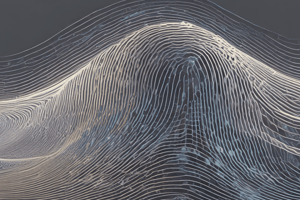Podcast
Questions and Answers
What is the amplitude of a wave?
What is the amplitude of a wave?
- The maximum displacement above or below the resting position. (correct)
- A wave in which particles move perpendicular to the wave direction.
- The point of maximum density in a medium.
- Distance between two crests.
What is compression in a longitudinal wave?
What is compression in a longitudinal wave?
Point of a medium with maximum density.
What is a crest in a wave?
What is a crest in a wave?
The point with maximum upward displacement.
What characterizes an electromagnetic wave?
What characterizes an electromagnetic wave?
What does frequency measure?
What does frequency measure?
What is a longitudinal wave?
What is a longitudinal wave?
What is a mechanical wave?
What is a mechanical wave?
What is a medium in wave terminology?
What is a medium in wave terminology?
What is a period in wave physics?
What is a period in wave physics?
What is a pulse in wave terms?
What is a pulse in wave terms?
What is rarefaction in a longitudinal wave?
What is rarefaction in a longitudinal wave?
What defines a surface wave?
What defines a surface wave?
How is a transverse wave defined?
How is a transverse wave defined?
What is a trough in wave terminology?
What is a trough in wave terminology?
What is a wave?
What is a wave?
What is wavelength?
What is wavelength?
Where is a crest of a wave located?
Where is a crest of a wave located?
Where is a trough of a wave located?
Where is a trough of a wave located?
Where is the amplitude of a wave found?
Where is the amplitude of a wave found?
Where is the wavelength of a wave measured?
Where is the wavelength of a wave measured?
What is the speed equation in wave mechanics?
What is the speed equation in wave mechanics?
Velocity is equal to _____ in wave physics?
Velocity is equal to _____ in wave physics?
What is the frequency formula?
What is the frequency formula?
What is the period formula?
What is the period formula?
What is beat frequency?
What is beat frequency?
As the wavelength of a wave in a uniform medium increases, its speed will _____.
As the wavelength of a wave in a uniform medium increases, its speed will _____.
As the wavelength of a wave in a uniform medium increases, its frequency will _____.
As the wavelength of a wave in a uniform medium increases, its frequency will _____.
The speed of a wave depends upon _____?
The speed of a wave depends upon _____?
If two waves on identical strings have frequencies in a ratio of 2 to 1, how do their wavelengths compare?
If two waves on identical strings have frequencies in a ratio of 2 to 1, how do their wavelengths compare?
What are the amplitude, period, and wavelength of Mac and Tosh's wave?
What are the amplitude, period, and wavelength of Mac and Tosh's wave?
As the frequency of waves is doubled, what happens to the wavelength?
As the frequency of waves is doubled, what happens to the wavelength?
What is the frequency in Hertz of a hummingbird with wing beats of about 70 beats per second?
What is the frequency in Hertz of a hummingbird with wing beats of about 70 beats per second?
Determine the frequency and speed of ocean waves as observed in a storm?
Determine the frequency and speed of ocean waves as observed in a storm?
Will the reflected pulse in medium 1 be inverted?
Will the reflected pulse in medium 1 be inverted?
The speed of the transmitted pulse will be __________ than the incident pulse.
The speed of the transmitted pulse will be __________ than the incident pulse.
The speed of the reflected pulse will be __________ than the incident pulse.
The speed of the reflected pulse will be __________ than the incident pulse.
The wavelength of the transmitted pulse will be __________ than the incident pulse.
The wavelength of the transmitted pulse will be __________ than the incident pulse.
The frequency of the transmitted pulse will be __________ than the frequency of the incident pulse.
The frequency of the transmitted pulse will be __________ than the frequency of the incident pulse.
Will the reflected pulse in medium 1 be inverted due to the transition from less to more dense?
Will the reflected pulse in medium 1 be inverted due to the transition from less to more dense?
The speed of the transmitted pulse will be __________ than the speed of the incident pulse.
The speed of the transmitted pulse will be __________ than the speed of the incident pulse.
The speed of the reflected pulse will be __________ than the speed of the incident pulse.
The speed of the reflected pulse will be __________ than the speed of the incident pulse.
The wavelength of the transmitted pulse will be __________ than the wavelength of the incident pulse.
The wavelength of the transmitted pulse will be __________ than the wavelength of the incident pulse.
The frequency of the transmitted pulse will be __________ than the frequency of the incident pulse.
The frequency of the transmitted pulse will be __________ than the frequency of the incident pulse.
Flashcards are hidden until you start studying
Study Notes
Wave Properties and Definitions
- Amplitude: Maximum displacement from the resting position of a mass.
- Crest: The highest point of a wave indicating maximum upward displacement.
- Trough: The lowest point of a wave indicating maximum downward displacement.
- Compression: Location in a longitudinal wave with maximum density.
- Rarefaction: Location in a longitudinal wave with minimum density.
- Wavelength: Distance between two consecutive crests or troughs.
- Period: Time taken for one complete wave cycle.
- Pulse: A single disturbance traveling through a medium.
Types of Waves
- Transverse Wave: Particles move perpendicular to the wave's direction.
- Longitudinal Wave: Particles move parallel to the wave's direction.
- Mechanical Wave: Requires a medium for energy transmission, cannot travel through a vacuum.
- Electromagnetic Wave: Can transmit energy through a vacuum.
Wave Characteristics
- Speed: Determined by the medium's properties; calculated using equations: ( \text{speed} = \frac{\text{wavelength}}{\text{period}} ) or ( \text{speed} = \text{wavelength} \times \text{frequency} ).
- Frequency: Number of complete cycles per time unit, calculated with ( f = \frac{1}{p} ) (where ( p ) is the period).
- Beat Frequency: Determined by the difference in frequencies of two waves, expressed as ( f_1 - f_2 ).
Relationships Between Wave Properties
- Increasing wavelength in a uniform medium implies frequency will decrease.
- Frequency and wavelength are inversely related; as one increases, the other decreases.
- The speed of transmitted pulses can be different from reflected pulses depending on the medium's density.
- When transitioning from a less dense to a more dense medium, the reflected wave will be inverted.
Practical Examples and Calculations
- Given a wave's amplitude of 16 cm, wavelength of 96 cm, frequency of 2.4 Hz, and speed of 230 cm/s.
- Ruby-throated hummingbird wing beats at 70 beats/s correspond to a frequency of 70 Hz; a wave moving at 350 m/s has a wavelength of 5.0 m.
- Ocean waves observed to have a frequency of 0.161 Hz and speed of 1.4 m/s based on height and horizontal distance measurements.
Reflection and Transmission of Waves
- The reflected pulse in a medium transitioning from less to more dense will not be inverted, while speed and frequency remain the same.
- The wavelength of transmitted pulses can increase compared to the incident wave in a less dense medium and decrease when going from a more dense medium back to less dense.
Key Equations and Effects
- Speed equations involve both wavelength and frequency; changes in one will affect the other.
- The reflected pulse's characteristics depend on the density change between mediums, impacting its speed and wavelength.
Studying That Suits You
Use AI to generate personalized quizzes and flashcards to suit your learning preferences.




